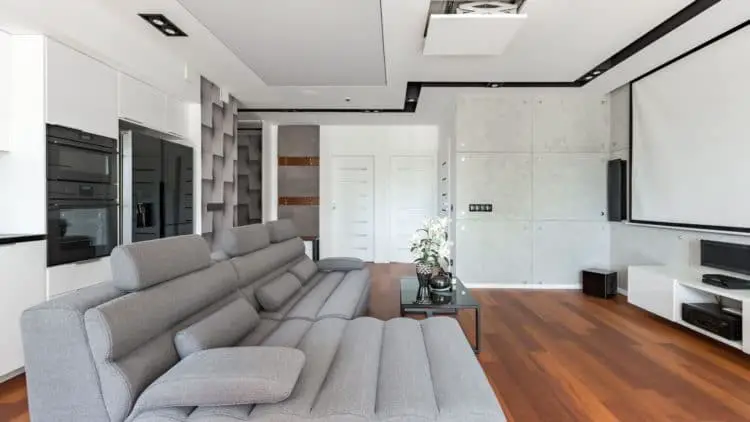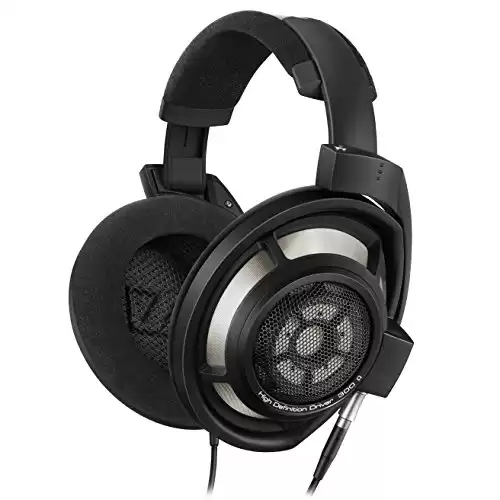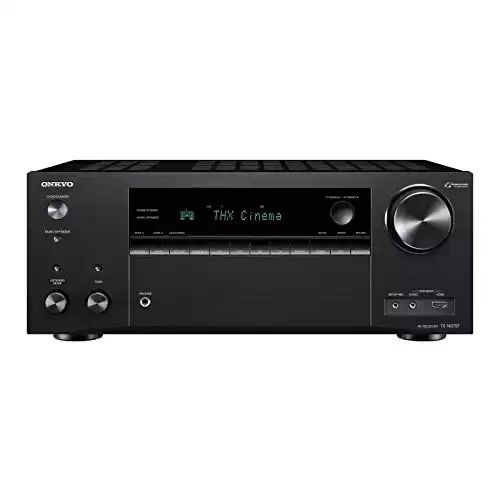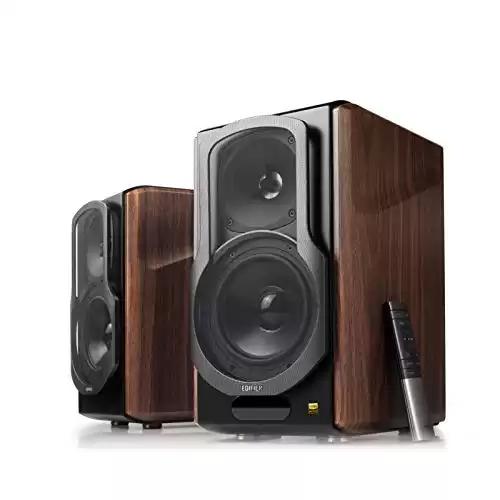Imagine that you’ve been invited to a small theater production of your favorite show. The building is compact, placing the orchestra in a bit just off the stage and in front of the first audience members.
Your seat is right in the middle of the auditorium. You can see how each instrument is positioned in the orchestra pit, with the percussion at the back while the strings are stacked in the seats closest to the conductor.
When the actors start performing, imagine that you close your eyes. Are you able to “see” the orchestra as it plays?
That’s the idea behind soundstaging. It is the imaginary three-dimensional feeling that occurs through a hi-fi reproduction of an audio recording.
What Is a Soundstage and How Important Is It?
Soundstage is the area of a movie studio, stage, or room where the acoustic properties are suitable for audio recording. It’s typically used for recording dialogue, although it is also helpful for music and more. When combined with imaging techniques, it produces the illusion of 3D sound.
If you have ever attended a concert, movie, or theater performance where the audio felt like it was “off,” you experienced a soundstaging issue. That’s because the room’s acoustics were unable to deliver an authentic result.
Your brain said, “Something isn’t right here.” That thought caused you to pay more attention to the problem, which led you to a result that meant less enjoyment.
Some stages, rooms, and recording studios offset their soundstaging problems by placing microphones strategically around a room.
Although this effort can reduce flat dynamics because the audio gets electronically reflected, the results are not the same as if a true soundwave bounce occurred.
That’s why some CDs don’t sound great, even if they’ve been given the latest recording and transfer techniques. You cannot fix flat audio after it gets recorded, even with remastering.
From an audiophile perspective, soundstaging is crucial to the listening experience because it communicates authenticity. When you can close your eyes and feel that you’re right there at the recording session, the audio equipment is doing its job correctly.
You should be able to “hear” the location of each instrument on the recording. If that result doesn’t occur, it hasn’t been soundstaged correctly.
How Can Audio Engineers Create a Soundstage?
Several factors go into a soundstaging experience. The one that gets overlooked the most is the listener’s imagination.
It all depends on what the listener wants to experience when hearing music play. Some people are content to throw on some cheap headphones while listening to Taylor Swift’s latest hit – and that’s okay! If it makes them happy, that’s the only thing that matters.
Some people prefer to hear a deeper musical soundscape than a $20 pair of Bluetooth® headphones can offer. These people don’t need to consider themselves audiophiles to appreciate a more immersive experience.
If you’re looking for ways to overlook the realities that your headstage provides, you’re ready to think about designing a better soundstage at home to enjoy.
◼️ Sound Capturing Technologies Contribute to the Soundstage
Another crucial element of a detailed soundstage’s creation is how audio’s initial capture and production occur.
The way that microphones record instruments, vocalists, or sections determine the auditory artifacts that get left in the final product. They’ll also contribute ambient cues that add to the 3D atmosphere that soundstaging creates.
Ambient cues provide tells to the listener as to where the instrument’s location is during the recording process.
When the sound of a trombone is louder and more explicit in the mix than other instruments, it gives the track the impression that the musician is closer to the listener.
If there is less textural detail to the instrument, especially when delay and reverberation are part of the mix, it can seem like the musician is further away from the listener.
Additional techniques that contribute to this 3D effect include tone, panning, and volume. The goal is to replicate what it would be like to hear the orchestra, symphony, or band when it is playing live.
Sound capturing technology creates the perception of these elements so that it gets pressed into the record or added to the digital file.
◼️ Speaker and Amplify Designer Contribute to the Effect
When creating a high-quality soundstage at home, your speaker and amplifier design contribute to developing this effect. That’s why manufacturers offer different combinations of driver materials, speaker size, tube types, transformers, crossover components, preamps, and power amp components.
All these features can dramatically impact how a speaker accurately reproduces sound. Even the cabinet that contains this technology plays a role in forming the 3D soundscapes that audiophiles and casual listeners enjoy when hearing their favorite albums.
Several cabinet designs all tout their own benefits. If you talk to avid audiophiles, most of them can likely tell you about the differences between open baffle speakers, bipolar speakers, and dipolar speakers. You can even get a different listening experience with a front-firing design.
◼️ Speaker Placement Has a Role in Soundstaging
Different speakers get designed and tuned in different ways. The goal is to optimize the relationship this technology has with the listener’s environment.
When you’re creating a soundstage at home, the goal is to find the “sweet spot” where the best sounds are heard for any given speaker pair.
This work often depends on where you plan to sit in a room. The acoustics next to a picture window or a fireplace are quite different from what they are for a chair in the middle of that living space.
If you want to obtain an unparalleled listening experience with your current speakers, you’ll need to think about these dimensional speaker aspects.
- What is the distance between the two speakers that transmit audio?
- How far are the speakers from nearby walls?
- What is the distance between the listener and the speaker?
- How tall are the speakers compared to where the listener will be experiencing the music?
- What is the vertical angle of the speakers?
- How steep is the horizontal speaker angle?
Each factor has a noticeable (and often considerable) impact on the overall listening experience. That’s why each one should be taken into consideration when developing a home soundstage to enjoy.
Although this work can take some time and requires a little patience, it’s also a lot of fun. The educational process for those seeking more knowledge of how speakers function and how they impact the environment can help numerous other ways, from TV enjoyment to balancing the EQ in your vehicle while jamming out to Taylor Swift at a red light.
Why Is Soundstaging Important in Modern Music?
Although audiophiles might disagree, soundstaging isn’t important unless a listener deems that it is an essential part of their experience.
Audio, sound, and music have different definitions for each person. What you find important is different from what I want, and someone else might have a completely unique perspective from you or me.
Although lengthy forum posts, blogs, and website pages get into the finer details of why one idea is better than another, the fact is that anything that you like is a great concept to pursue. We shouldn’t be judging each other based on the way that we embrace music and sound.
If you want to create a unique immersive sound, it helps to get advice from others who have pursued a similar process. Their mentorship can help you decide which speakers, stereos, and other equipment are necessary to create what you want.
Once you come to a place where what you hear with music equates to what your mind sees, soundstaging becomes one of the most important pieces of the overall experience. It allows music to exist in a larger, 3D space that you can access from the comfort of your couch, chair, or bed.
Best Audiophile Equipment to Use Today
If you’re looking for ways to create soundstaging at home, you’ll need to invest in some equipment to produce the audio you want to hear.
Since each home, room, and setting has different features to consider, you’ll need to adapt to the acoustics in each situation. That’s why taking a well-rounded approach to your overall needs is helpful.
When you have speakers, headphones, receivers, and more to support your listening enjoyment, you’ll discover that soundstaging can be lots of fun!
- Frequency Response: 4 Hz to 51,000 Hz
- Impedance: 300 Ohms
- Sensitivity: 103 decibels at 1 kHz; 1V
- Cable: 9.8 feet (3 meters); Detachable
- THD: < 0.02%
- Weight: 11.6 ounces (330g) – without cable
- Included Accessories: Cable /w 6.3mm stereo plug, 4.4mm Pentaconn plug
- USB Manual With Frequency Response Plot
- Deluxe Storage Container
◼️ Best Headphone System for Soundstaging: Sennheiser HD 800 S
The Sennheiser HD 800 S delivers an impressive three-dimensional sound that works for almost any musical genre or audio source.
It’s a wired system that won’t lose depth or quality from a wireless transmission while offering an around-ear design that prevents leakage or loss at the headstage.
It uses 56mm ring radiator transducers, offering the largest drivers the brand has ever used when creating their dynamic headphones.
Sennheiser incorporates absorption technology to reduce unwanted frequency peaks and responses to ensure that each nuance becomes discoverable to the listener.
The other feature that makes these headphones such a great investment is the ear cup design.
You’ll hear the audio waves coming from a slight angle to create more authenticity with the listening experience. It includes two connecting cables.
◼️ Best Channel Receiver for Soundstaging: Onkyo TX-NR797
This receiver delivers 220W per channel supporting HDR10 sound, Dolby Atmos, and more to ensure that you get an authentic sound reproduction every time.
It comes with a smart AV receiver to create a multi-room experience, or you can hook it up to your television to reproduce what you’d hear when attending an IMAX® show.
The DTS:X setting maps the sounds to their corresponding positions in your room. That makes the audio feel more localized as it moves through the rest of your sound system.
Even if you’re watching a classic movie without audiophile support, the unit’s up-mixers create an improved experience,
The Onkyo TX-NR797 Channel Receiver can even join an existing Sonos home sound system, start a new one, or get paired with that brand’s Connect technology.
It is a theater-reference sound that you can enjoy without breaking the budget.
◼️ Best Entry-Level Soundstage Speakers for Home Use
When you have the Edifier S2000 Mk III powered Bluetooth bookshelf speakers to use at home, you receive a tri-amped design at 130W to deliver a studio-quality experience.
They offer a line-in and an optical input while using latency-reducing tech to give you an authentic sound through aptX HD decoding.
Edifier built these speakers with 5.5-inch woofers and planar diaphragm tweeters for a crisp, potent sound. You can connect them to multiple sources to avoid swapping your input with the innovative design.
If you get tired of switching your EQ for each music genre, these speakers offer four presets to enjoy: vocal, classical, dynamic, and monitor.
When you want to turn Bach or Beethoven into a lifelike experience, this technology delivers the desired results.
It’s also perfect for podcasts, audiobooks, and other vocal-based recordings.
◼️ Best Intermediate Soundstage Speakers for Home Use: Wharfedale-Linton
The Wharfedale-Linton loudspeakers come on dedicated stands so that you can adjust the audio profile for any room.
They provide a three-way design that delivers a tight bass and elevated openness to ensure you receive the soundstaging you want.
It uses a classic design with modern technology to deliver stunning results. You’ll get an eight-inch woofer, a five-inch mid, and a one-inch soft dome tweeter to exude timeless character in each composition.
The primary component for the lows and mids is Kevlar to ensure that you receive a robust experience.
These speakers use an inset front baffle with the traditional grille to provide a classic look for your room. You’ll get the listening axis at the right spot with the enclosure and vibration.
This product might deliver vintage style, but it offers timeless audio performances that enhance your listening pleasure immediately.
- Maximum Output Power: 500 Watts
- Woofer Diameter: 8"
- Frequency Response: 25Hz - 40KHz
- Sensitivity: 87dB+/-3dB
- Impedance: 4 Ohms
- Crossover frequencies: 350 Hz, 3.2 KHz, 10 KHz
- Recommended Amp Power: 100 WRMS - 500 WRMS
◼️ Best High-End Soundstage Speakers: Earthquake Tigris
The new Tigris speakers from Earthquake Sound feature a tower-stye design with a single silk dome NEO tweeter that offers background support for the two other ball-loaded ones that fire off some impressive mids.
You’ll get dual eight-inch Kevlar woofers with this design, enclosed and shaped like an oval, to offer minimal reflections as audio waves get produced.
When you include the entire range with all three speaker sets, you’ll go from 30 Hz to 35 kHz, creating an impressive soundstage that you’ll never want to leave.
You’ll need to invest in an amp that delivers at least 100 WRMS to maximize this investment, but it can handle up to 500 WRMS when you have tons of space to fill.
You’re going to need at least 200W per channel to see what these speakers can do. The bass is better than anything you’ve heard, and the rest of the technology speaks for itself.
◼️ Best Speaker Wire for Audiophile Equipment: JORZOR 13AWG
The reason why your speakers might be underperforming could involve how they’re wired. When you use a standard product, including coax, the transmission doesn’t always arrive as it left the source. If that happens, you’ll end up with a low-quality result.
That’s why the JORZOR audiophile-grade 13AWG speaker wire is a reasonable investment to consider.
It uses gold-plated banana plug tips with an oxygen-free copper construction to produce one of the best lossless experiences available today.
You can get varying lengths, ranging from an affordable 3 feet for a close setup to nearly 100 feet to support the entire room. You’ll notice improvements to your speaker’s sound immediately.
Could You Benefit from Soundstaging Today?
The best soundstaging opportunities use a soundproof room, stage, platform, or building to produce content. If you record music or play concerts live, the audio should project toward the audience to make the sounds feel authentic through a stereo-like effect.
I’ve found that soundstaging has some pros and cons to consider.
The benefits are pretty straightforward. When you invest in the technologies needed to enhance your listening experience, each album, single, or digital file sounds more authentic. If you have an SACD-compatible player, it’ll feel like the band is right there in your living room.
Most audiophile equipment sets up without any fuss. You’ll connect it to your existing system, install the speakers to a new receiver, and test for the sweet spot in your room. It only takes a couple of hours to set up at the most.
As for the disadvantages, the cost is the primary obstacle for most people. If you have $8,000 or more to spend on speakers, that equates to a new motorcycle or a year’s worth of groceries for a family of four. The benefits don’t always outweigh the expense.
That’s why I highly recommend looking at the midrange and entry-level audiophile listening options that are available today.
Although you’ll spend more on this equipment than the $99 special at a local store, the audio benefits can help you embrace your favorite songs and performances at new levels.








